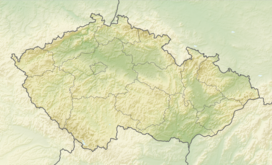Moravian-Silesian Beskids
| Moravian-Silesian Beskids | |
|---|---|
| Moravskoslezské Beskydy | |

Smrk mountain in early spring
|
|
| Highest point | |
| Peak | Lysá hora |
| Elevation | 1,323 m (4,341 ft) |
| Coordinates | 49°32′45″N 18°26′51″E / 49.54583°N 18.44750°ECoordinates: 49°32′45″N 18°26′51″E / 49.54583°N 18.44750°E |
| Geography | |
| Countries | Czech Republic and Slovakia |
| States/Provinces | Moravian-Silesian (Czech Repub.) and Žilina (Slovakia) |
| Parent range | Western Beskids |
| Geology | |
| Orogeny | Alpine |
| Age of rock | Miocene |
| Type of rock | Godulian sandstone |
The Moravian–Silesian Beskids (Czech: Moravskoslezské Beskydy , Slovak: Moravsko-sliezske Beskydy) is a mountain range in the Czech Republic with a small part reaching to Slovakia. It lies on the historical division between Moravia and Silesia, hence the name. It is part of the Western Beskids, which is in turn part of the Outer Western Carpathians.
The mountains were created during the Alpine Orogeny in the Cenozoic. Geologically, they consist mainly of flysch deposits. In the north, they steeply rise nearly 1,000 m (3,300 ft) over a rather flat landscape; in the south, they slowly merge with the Javorníky. In the south-west, they are separated from the Vsetínské vrchy by the Rožnovská Bečva valley; in the north-east, the Jablunkov Pass separates them from the Silesian Beskids.
The highest point is Lysá hora mountain at 1,323 m (4,341 ft), which is one of the rainiest places in the Czech Republic with around 1,500 mm (59 in) of precipitation a year. Many legends are bound to Radhošť Mountain, 1,129 m (3,704 ft), which is one of the most visited places in the mountains together with the nearby Pustevny resort.
Smrk, with a height of 1,276 m (4,186 ft), is the second highest summit of the range. Its northern slope steeply rises from the surrounding lowlands and is separated from the rest of the mountains by the deep Ostravice River (in the east) and Čeladenka (in the west) river valleys; in the south, it merges in the lower Zadní hory (i.e. Rear mountains) area.
...
Wikipedia

